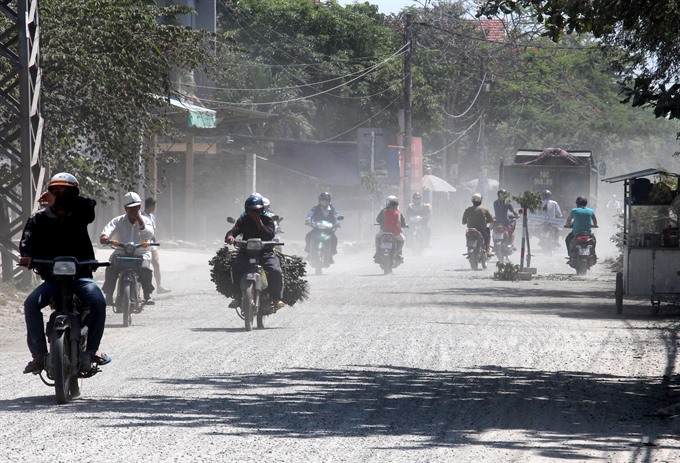 Environment
Environment

Việt Nam’s urban environment, especially in big cities, is facing numerous challenges, including air and water pollution, solid waste treatment and flooding, according to the 2016 National Environmental Report issued on Thursday in Hà Nội.
 |
| Motorbike drivers wear masks on a local road in Quảng Ngãi City. The urban environment in Việt Nam is facing many problems, including air pollution. — VNA/VNS Photo Phước Ngọc |
HÀ NỘI — Việt Nam’s urban environment, especially in big cities, is facing numerous challenges, including air and water pollution, solid waste treatment and flooding, according to the 2016 National Environmental Report issued on Thursday in Hà Nội.
The report by the Ministry of Natural Resources and Environment said that on average, during more than 70 days of the year dust concentrations of PM10 and PM2.5 are much higher than the permitted concentration. In the northern region, winter days between November and March often record higher dust concentrations than other days.
Only 42 of about 790 urban areas across the country have wastewater treatment systems meeting standards, the report said. In Hà Nội, only 20.6 per cent of household wastewater is treated before being discharged into the environment.
Rivers, lakes and canals in Hà Nội and HCM City are the most polluted, among the Tô Lịch, Lừ and Sét rivers in Hà Nội, and the Tân Hóa–Lò Gốm, Ba Bò, Tham Lương canals in HCM City.
The report also pointed out that 46 per cent of underground water in Hà Nội was found to contain higher than permitted arsenic concentrations, especially in the two districts of Hoàng Mai and Long Biên.
Although 85 per cent of solid waste was collected in urban areas of the country, the percentage of solid waste treated according to standards was very small.
The report said solid waste was mainly treated by burying and burning, but most dumping sites and incinerators failed to meet standards.
Urban areas have suffered from flooding during torrential rains in recent years, especially in Hà Nội and HCM City.
Causes and solutions
Hoàng Dương Tùng, deputy director of the ministry’s Việt Nam Environment Administration, said vehicle fumes and construction sites are mainly to blame for air pollution in urban areas.
Coaches and trucks were found to mainly discharge nitrogen dioxide (NO2) and sulfur dioxide (SO2), while motorbikes mainly emit carbon monoxide (CO) and volatile organic compounds (VOC), he said.
Việt Nam now has about 47 million motorbikes and about three million cars, he said.
Increasing population in urban areas and inadequate infrastructure were responsible for the virtually total absence of wastewater treatment systems meeting standards, he said.
The small rate of solid waste treated in urban areas is attributed to lack of investment and backward technologies for collecting and treating waste, he said. Poor drainage systems due to poor planning in urban areas was the main cause of flooding, he said, adding that high tides triggered by climate change also resulted in the inundations in big cities, such as HCM City.
The report also provided recommendations to remedy the problems. Authorised agencies were advised to tighten control to minimise emission sources, including conducting more checks on vehicle emissions as well as ensuring sanitation at construction sites.
Additional wastewater treatment systems need to be built in urban areas and drainage systems upgraded to prevent flooding during torrential rains and high tides.
The administration of urban areas was asked to invest more in new technologies to improve their capacity to treat waste.
Painful lessons
The national environmental report included a section on major environmental incidents in 2016. The first was the massive fish deaths in four coastal provinces caused by the Taiwanese Hưng Nghiệp Formosa Hà Tĩnh Steel Corporation last April by releasing toxic wastewater into the sea. The company has compensated the people affected.
The report also mentioned the water pollution in Bưởi River in the northern province of Hòa Bình between March and April 2016, after a factory discharged untreated wastewater into the river.
Also listed was the case of 190 tonnes of fish killed by water pollution in Hà Nội’s West Lake in September.
The next incident was the collapse of the reservoir of the titanium exploitation project implemented by Tân Quang Cường Company in Bình Thuận Province, leaving thousands of cubic metres of red mud overflowing into Nam Thuận Quý tourism site and flooding the roads. The ministry said poor management by the local administration and poor implementation of environmental protection by the mine’s owners were to blame.
Agencies must draw lessons from these painful incidents to ensure such disasters do not recur, the ministry said. — VNS




